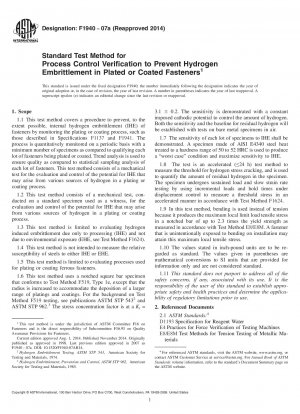ASTM F1940-07a(2014)
Standard Test Method for Process Control Verification to Prevent Hydrogen Embrittlement in Plated or Coated Fasteners
- Standard No.
- ASTM F1940-07a(2014)
- Release Date
- 2007
- Published By
- American Society for Testing and Materials (ASTM)
- Status
- Replace By
- ASTM F1940-07a(2019)
- Latest
- ASTM F1940-07a(2019)
- Scope
5.1 This test method establishes a means to verify the prevention, to the extent possible, of IHE in steel fasteners during manufacture by maintaining strict controls during production operations such as surface preparation, pretreatments, and plating or coating. It is intended to be used as a qualification test for new or revised plating or coating processes and as a periodic inspection audit for the control of a plating or coating process.
5.2 Passing this test allows fasteners to be stressed in tension to the minimum specified tensile load in air with almost no possibility of time delayed fracture in air as a result of IHE from processing. If the amount of residual hydrogen is not sufficient to induce cracking or fracture in the specimen under worst case conditions, then it can be concluded that all of the lots of fasteners processed during that period will not have sufficient residual hydrogen from processing to induce hydrogen embrittlement of the fasteners under stress in air if the process remains in control, unchanged and stable.
5.3 If certified specimens with demonstrated sensitivity to IHE, processed with the fasteners, have a threshold ≥758201;% of the incremental step load notched bend fracture stress, NFS(B)F1624, it is assumed that all fasteners processed the same way during the period will also pass any sustained load IHE test.
1.1 This test method covers a procedure to prevent, to the extent possible, internal hydrogen embrittlement (IHE) of fasteners by monitoring the plating or coating process, such as those described in Specifications F1137 and F1941. The process is quantitatively monitored on a periodic basis with a minimum number of specimens as compared to qualifying each lot of fasteners being plated or coated. Trend analysis is used to ensure quality as compared to statistical sampling analysis of each lot of fasteners. This test method consists of a mechanical test for the evaluation and control of the potential for IHE that may arise from various sources of hydrogen in a plating or coating process.
1.2 This test method consists of a mechanical test, conducted on a standard specimen used as a witness, for the evaluation and control of the potential for IHE that may arise from various sources of hydrogen in a plating or coating process.
1.3 This test method is limited to evaluating hydrogen induced embrittlement due only to processing (IHE) and not due to environmental exposure (EHE, see Test Method F1624).
1.4 This test method is not intended to measure the relative susceptibility of steels to either IHE or EHE.
1.5 This test method is limited to evaluating processes used for plating or coating ferrous fasteners.
1.6 This test method uses a notched square bar specimen that conforms to Test Method F519,......
ASTM F1940-07a(2014) Referenced Document
- ASTM D1193 Standard Specification for Reagent Water
- ASTM E177 Standard Practice for Use of the Terms Precision and Bias in ASTM Test Methods
- ASTM E18 Standard Test Methods for Rockwell Hardness of Metallic Materials
- ASTM E1823 Standard Terminology Relating to Fatigue and Fracture Testing
- ASTM E29 Standard Practice for Using Significant Digits in Test Data to Determine Conformance with Specifications
- ASTM E399 Standard Test Method for Plane-Strain Fracture Toughness of Metallic Materials
- ASTM E4 Standard Practices for Force Verification of Testing Machines
- ASTM E691 Standard Practice for Conducting an Interlaboratory Study to Determine the Precision of a Test Method
- ASTM E8/E8M Standard Test Methods for Tension Testing of Metallic Materials
- ASTM F1137 Standard Specification for Phosphate/Oil Corrosion Protective Coatings for Fasteners*, 2024-04-20 Update
- ASTM F1624 Standard Test Method for Measurement of Hydrogen Embrittlement Threshold in Steel by the Incremental Step Loading Technique
- ASTM F1941 Standard Specification for Electrodeposited Coatings on Threaded Fasteners (Unified Inch Screw Threads (UN/UNR))*, 2024-04-20 Update
- ASTM F519 Standard Test Method for Mechanical Hydrogen Embrittlement Evaluation of Plating Processes and Service Environments
- ASTM G5 Standard Reference Test Method for Making Potentiostatic and Potentiodynamic Anodic Polarization Measurements
- SAE AMS2759 HEAT TREATMENT OF STEEL PARTS General Requirements
- SAE AMS3078 COMPOUND, CORROSION-PREVENTIVE Soft Film - Cold Application
- SAE AMS6415 STEEL Nickel Chromium Molybdenum
ASTM F1940-07a(2014) history
- 2019 ASTM F1940-07a(2019) Standard Test Method for Process Control Verification to Prevent Hydrogen Embrittlement in Plated or Coated Fasteners
- 2007 ASTM F1940-07a(2014) Standard Test Method for Process Control Verification to Prevent Hydrogen Embrittlement in Plated or Coated Fasteners
- 2007 ASTM F1940-07a Standard Test Method for Process Control Verification to Prevent Hydrogen Embrittlement in Plated or Coated Fasteners
- 2007 ASTM F1940-07 Standard Test Method for Process Control Verification to Prevent Hydrogen Embrittlement in Plated or Coated Fasteners
- 2001 ASTM F1940-01 Standard Test Method for Process Control Verification to Prevent Hydrogen Embrittlement in Plated or Coated Fasteners
- 1999 ASTM F1940-99 Standard Test Method for Process Control Verification to Prevent Hydrogen Embrittlement in Plated or Coated Fasteners

Copyright ©2024 All Rights Reserved